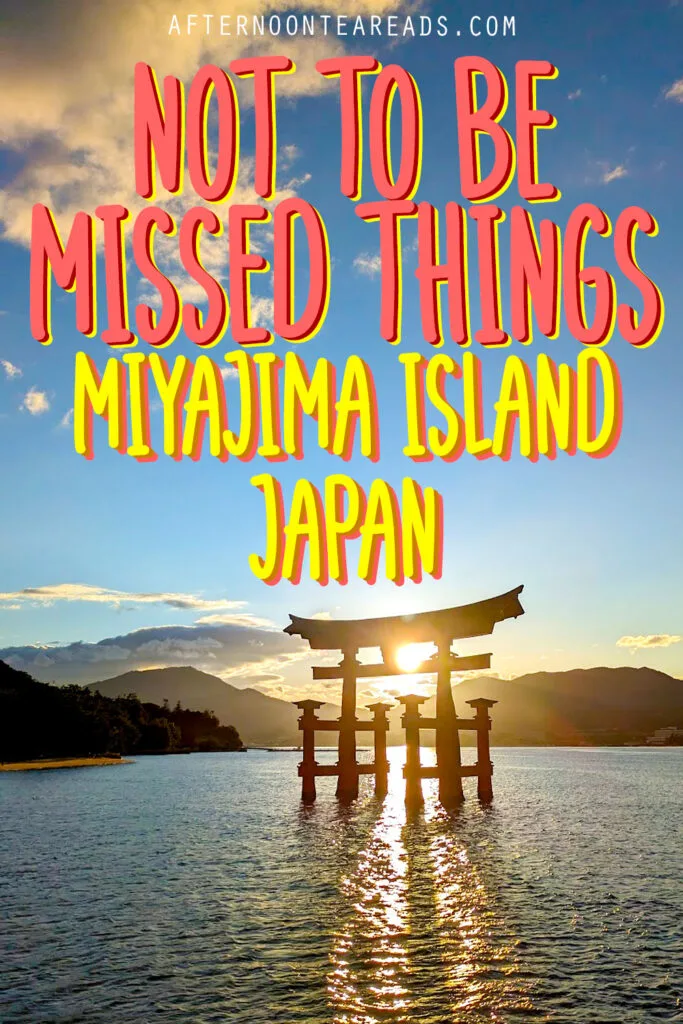Miyajima Island is a must visit in Japan.
It might be a tad out of the way from your Tokyo and Kyoto itinerary, but if you’re going to Hiroshima (which you should!), then it’s an easy day trip from there!
Miyajima Island is incredible to say the least. There’s a floating shrine and torii gate, mountain top views, and even local food to try.
So this is my Miyajima one day itinerary from Hiroshima.
Psst! This blog post contains affiliate links in it which sends me a bit of extra money if you use them… at no extra cost to you!
Is It Itsukushima or Miyajima Island?
You may have seen both names mentioned when researching Miyajima Island.
Itsukushima is the old name for the Island, and now it’s become more commonly known as Miyajima, which literally translates to “Shrine Island”.
But the shrine on the island is actually called the Istukishima Jinja shrine.
How To Get To Miyajima Island From Hiroshima: The Simplest Route
If you’re staying in the city centre of Hiroshima, the simplest way to get to Miyajima Island is by the Aqua Net Hiroshima. It is not a part of your JR pass if you have one, so it will be a separate cost.
It’s a boat that takes you from Hiroshima Peace Memorial Park, passing the Atomic Bomb Dome, along the river, and then across the sea straight to Miyajima.
The entire journey takes about 45 minutes, but you’re on the same boat the entire time!
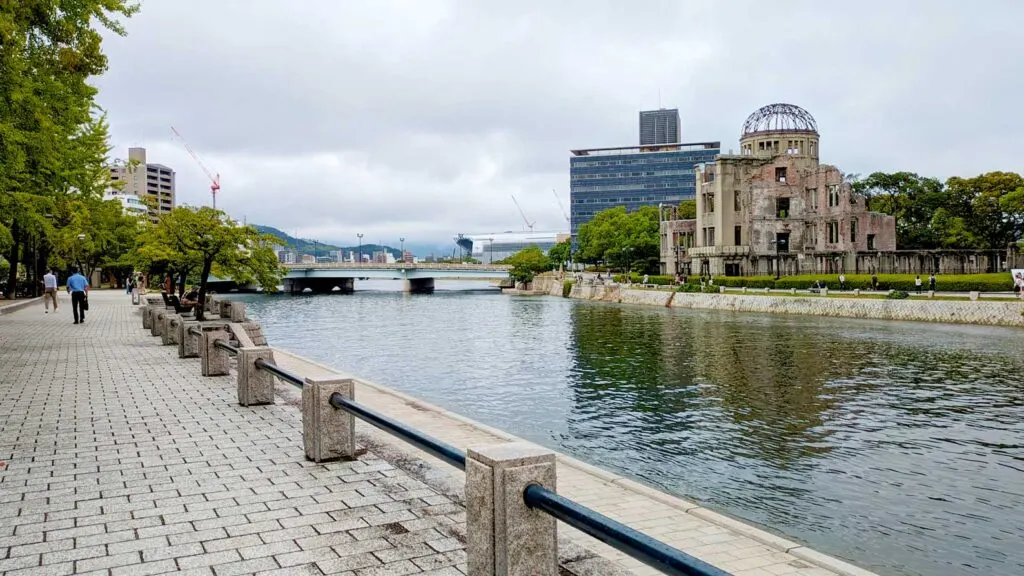
How To Get To Miyajima Island From Hiroshima Using Your JR Pass
If you have a JR pass, you’re ENTIRE trip is actually covered with your pass – even including the ferry!
From Hiroshima station, the entire journey takes about 45 minutes.

Plan the ultimate vacation
My digital travel planner template has everything you need to plan your vacation: research templates, travel planner itinerary, travel budget templates…etc. . You can print it out or use it digitally on your phone, tablet, or computer.
P.S. Get an additional discount on my Etsy shop with my code ATRLOVE!
Take The San-Yo Main Line
From Hiroshima station, get on the Local Iwakuni train on the San-yo Main line (NOT the Shinkansen!).
You’ll take the local train along the coast for about 30 minutes (9 stop) and get off at Miyajimaguchi Station.
Then you’ll need to make your way to the ferry station, about a 2 minute walk…
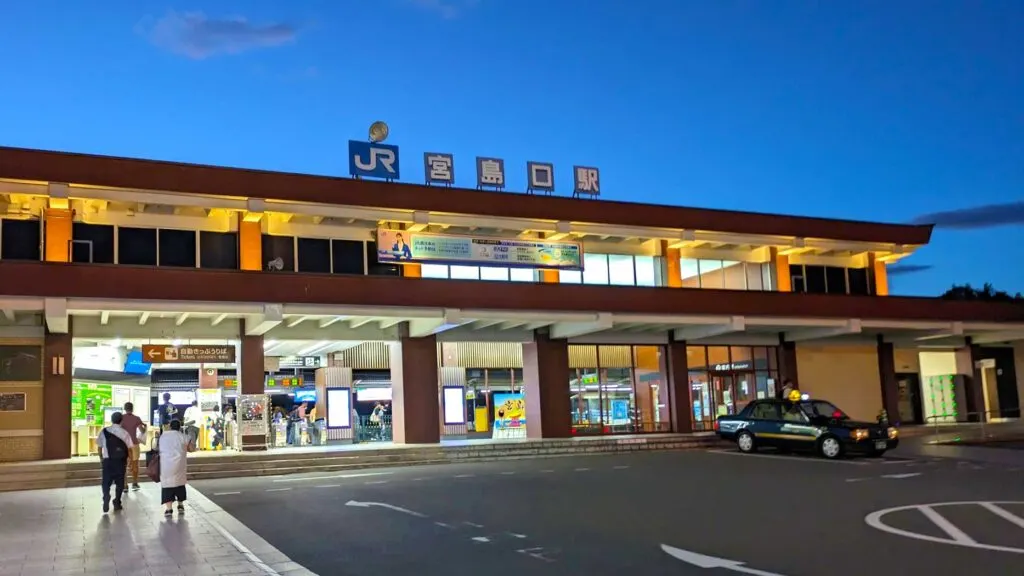
Miyajima Island Ferry (Included in JR Pass)
Once you’re off the train, follow signs for either the JR Miyajima Island ferry or the Miyajimaguchi Ferry Port (they both take you to the same place).
Keep in mind, there are a few companies that operate ferries to Miyajima Island. But, if you have the JR pass, only one ferry will be free for you.
The ferry leaves about every 15 minutes between 8:00 A.M. and 6:00 P.M.
It’s important to take note of the last ferry scheduled to leave from Miyajima if you need to get back to Hiroshima that night.
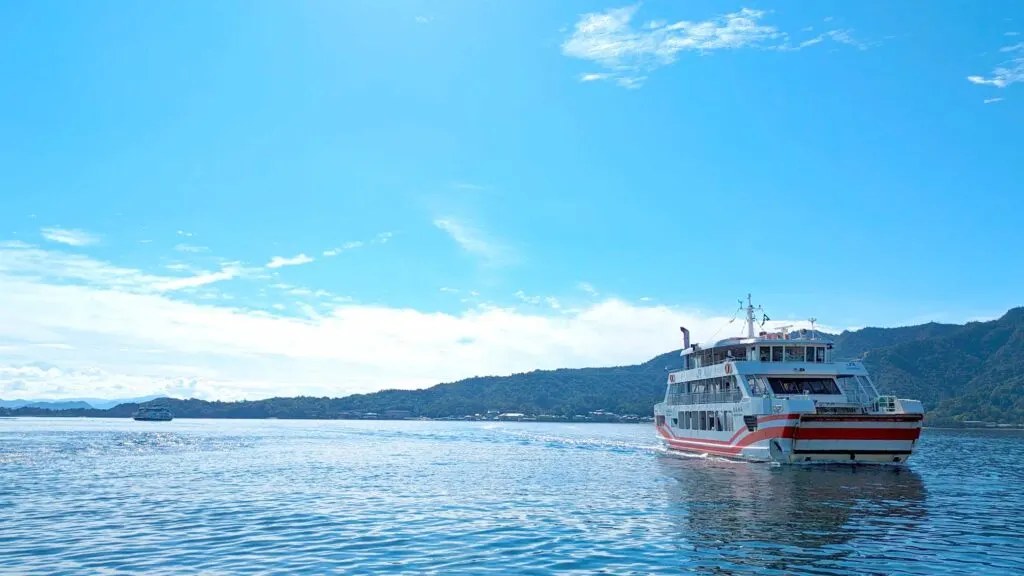
P.S. Minimize Travel Time By Staying At The Train Station In Hiroshima
I recommend staying at a hotel near Hiroshima Station. We stayed at the Sheraton Grand Hiroshima Hotel, it was a two minute walk to the train station.
Staying at the main train station is so convenient in Japan because it’s how you arrive and leave every city. But, it’s especially convenient for going on day trips too.
Day trips are already extremely long days, and now you’re not adding any extra travel time to your day.
This means you can either sleep in a bit more or have more time to explore your destination!
P.S. Stay organized when planning your trip to Japan, check out my travel planner on Etsy!

Top Things To Do Miyajima Island
There isn’t all that much to do in Miyajima Island as it’s quite small, but there are a few must-dos that make the trip worth the effort…
See Itsukushima Jinja Shrine & Ōtorii
The Itsukushima Jinja Shrine is undeniably the reason you’re visiting Miyajima Island, it has the “floating” torii gate.
But it’s not just the torii that’s floating, but also the actual shrine.
I mean, you’ve seen torii gates and shrines in Japan, but have you ever seen a floating one in the middle of the water?
Not to mention it’s also a UNESCO World Heritage Site as of 1996, and home to one of the biggest wooden torii gates in Japan (16 meters tall and 24 meters wide!).
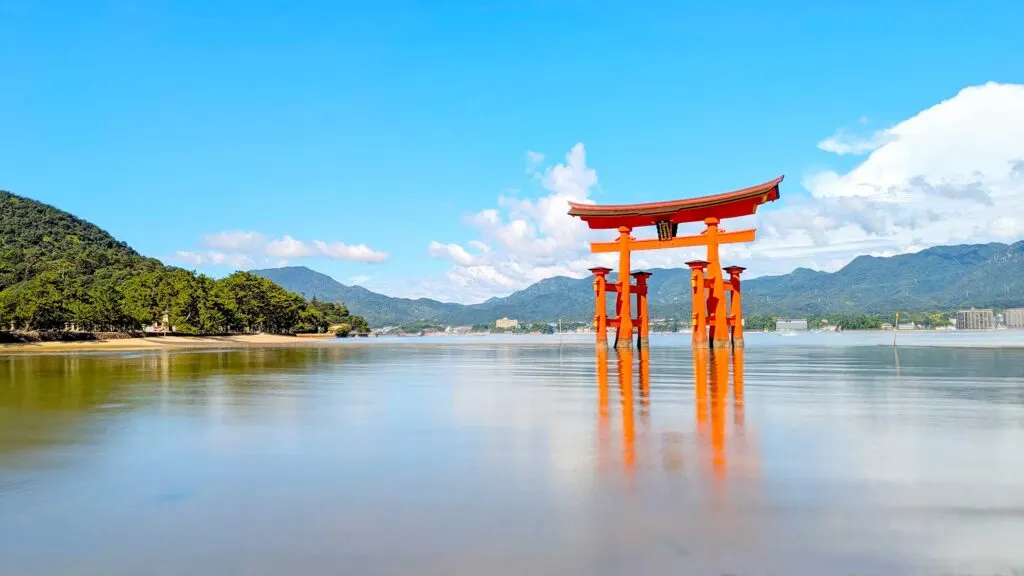
What Is A Torii Gate?
Torii simply means traditional Japanese gate. So when you say Torii gate, you’re kind of saying a traditional gate gate…
The torii gate is a part of a Japanese shrine, typically marking the entrance to welcome visitors, and mark the transition to a sacred space.
So the purpose of this floating torii was to welcome visitors to the shrine arriving by boat.
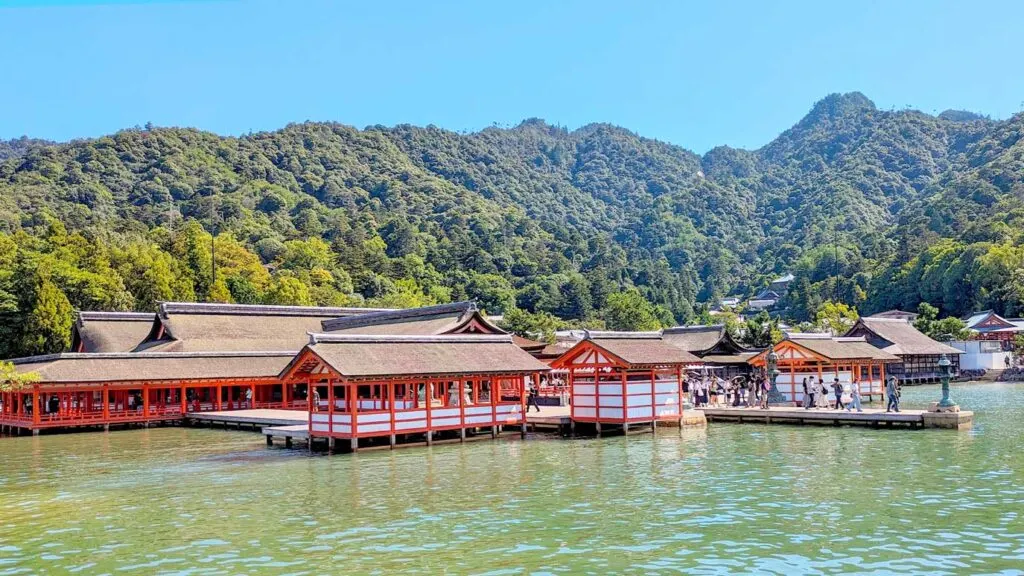
Find The Best Place To See The Floating Torii Gate
You’ll actually be able to see the torii gate on the ferry ride from Miyajimaguchi station. Make sure you’re on the right side of the boat though otherwise you’ll miss it!
Once you’re on the Island, make your way along the coast. The gate becomes larger and more magnificent the closer you get.
Depending on the tide, you’ll either be able to walk out onto the beach right up to it. Or you can book a boat ride to ride up next to it and coast through it.
But the most iconic view is actually from the shrine itself, at Hitasaki. You’ll need a ticket for the shine to get to this viewpoint. And during peak hours, there will be a line… not to buy an entrance ticket, but to take the iconic photo.
P.S. See the best spots according to a local on a walking tour of Miyajima Island.

The Best Time of Day To Visit Miyajima Island Shrine
As I said, you’ll need to buy a ticket to access the shrine. But! Your ticket is good for the entire day, so make sure not to loose it, because you’ll want to come back as often as you can.
That’s because you want to see both the shrine and the torii gate during the different tides.
The tide not only affects whether you’ll be walking to the torii gate or taking a boat, but also the look of it.
You can truly appreciate the sheer size of it when you’re up close. But the reflection in the water, and to see it floating is also unreal!
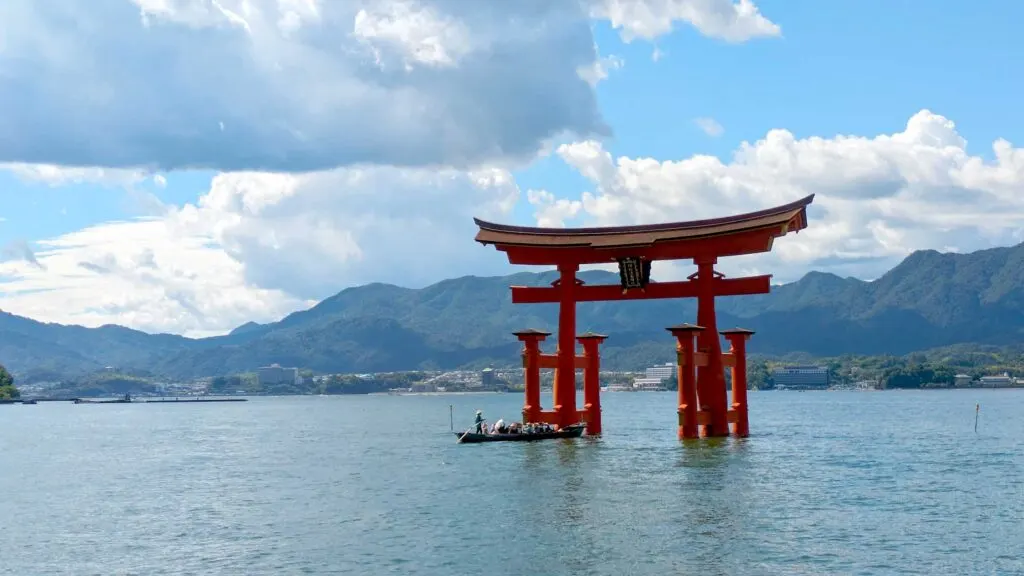
Not to mention how the shrine completely changes.
During low tide, it can be any other shrine over land. But during high tide, you feel like you’re walking on water (I was also very happy to have a phone lanyard so I didn’t accidentally drop it in the water below…).
But regardless of the time of day you see the torii gate, you HAVE to come back to watch the sunset.
The sun sets behind the torii gate, creating a magical moment for you to enjoy. To make it even better, grab a beer and something to eat for dinner from Omotesandō while you watch the sunset.
See the sunset times for when you’re visiting Miyajima.
P.S. Be sure to keep an eye on the ferry schedule if you’re heading back to Hiroshima for the night.
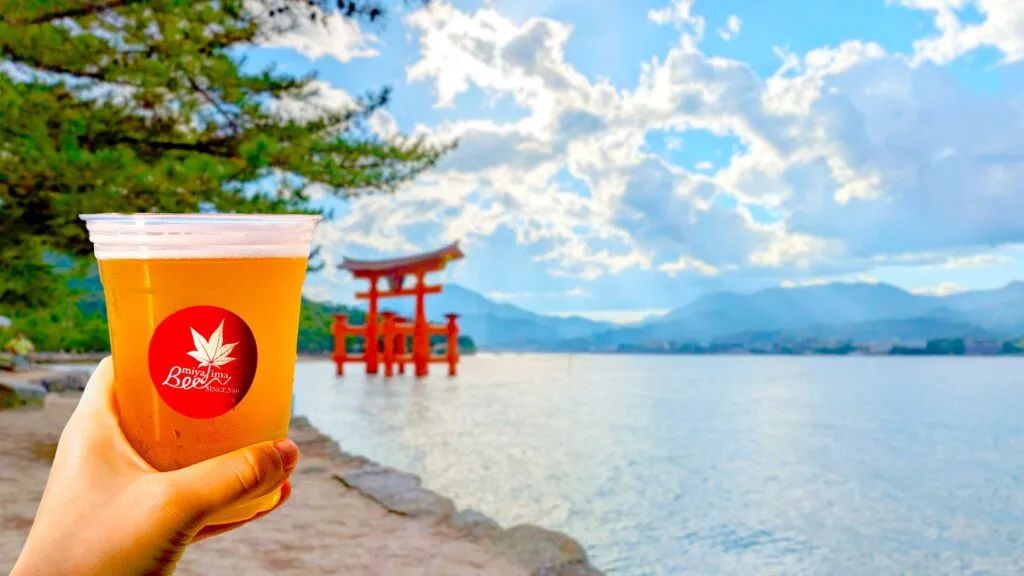
The Miyajima Ropeway
The Miyajima Ropeway is one of the top two major things to do in Miyajima Island, along with the shrine.
The Ropeway is a set of cable cars taking you to the top of Mount Misen.
At the top, there’s an aerial view of the Hiroshima prefecture and “miracle spots”, both historical and natural points of interest that they’ve named them “Misen’s Seven Wonders“.
Misen’s Seven Wonders include shrines and temples, but also some intriguing rock formations. Notably, Kuguri-iwa, the duck-under rock, and Fudo-iwa, the Acala rock.
But depending on when you’re visiting Japan, the Miyajima Ropeway may be more or less doable.
I visited during a heat wave in Japan and I was not properly informed or prepared for visiting Mount Misen, so ended up missing most of it… That’s because the Miyajima Ropeway doesn’t exactly take you to the top of Mount Misen…

Expect Long Wait Times For The Cable Cars
Depending on when you’re visiting, you should expect to have to wait for each cable car.
In fact, I saw that in May (not even peak high season) they had to close the line at 2:30 P.M. because there was already an hour and a half wait…
So if you are interested in the Miyajima Ropeway, make it one of the first things you do once you arrive on the island.
P.S. If there’s a long wait for the ropeway you can alternatively hike up and down the mountain. There are three hiking paths depending on where you want to go that take between 50 minutes to an hour and a half.
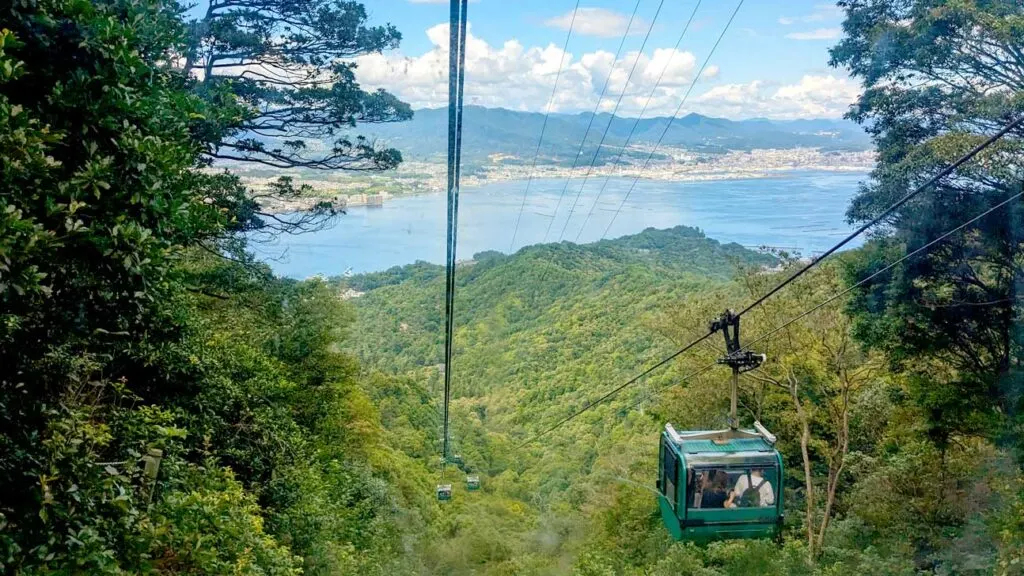
Be Prepared To Hike
The Miyajima Ropeway isn’t just one cable car to the top of a mountain.
Your journey to the top starts with either a 10 minute hike, or a 3 minute shuttle to the first cable car. This shuttle is included with your ticket for the cable car, they run about every 15 minutes.
The first cable car is about 10 minutes, and then you jump on a second four minute cable car to the first peak.
We did not realize that after a shuttle and two cable cars, you still aren’t at the summit of the mountain. There is an observation deck (Shishiiwa Observation deck), but you have to hike to everything else and the real peak.
In fact, it takes another 30 minute hike to reach the real summit of Mount Misen And that time doesn’t including stopping at any of the Seven Wonders on the way.

Expect Limited Resources At The Top
A 30 minute hike shouldn’t have been too much of a problem, but since we weren’t expecting a hike we hadn’t eaten anything since breakfast, and we thought there was a restaurant at the top.
Unfortunately for us, the restaurant was closed at the Shishiiwa Observation deck. We only found out when we were at the top, standing in front of a printed sign on their door… this would have been great information to have had at the bottom of the mountain…
There should be another cafe once you reach the Mount Misen Observatory, but I I can’t tell you from experience what they have there, we weren’t going to take any chances.
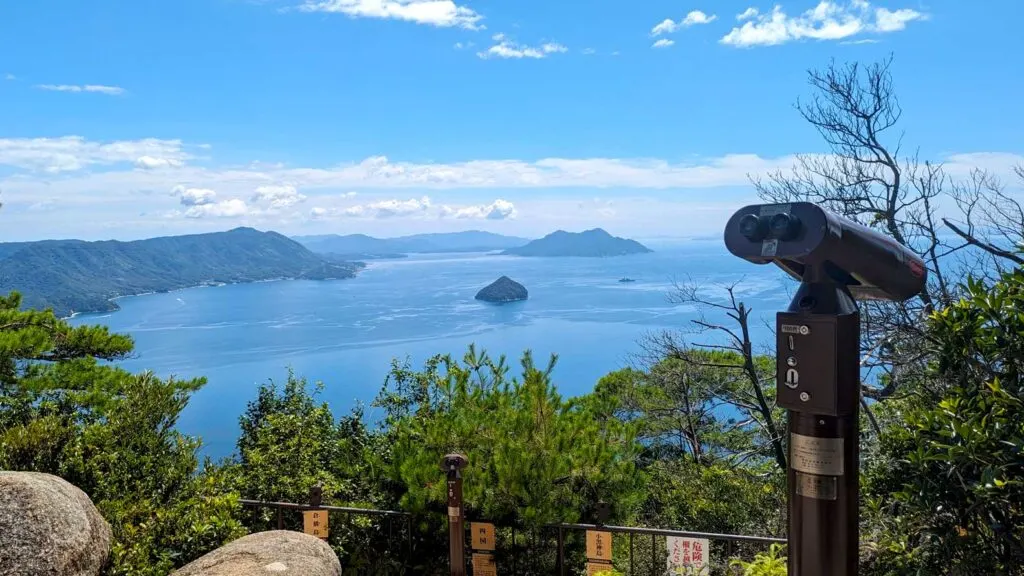
We also saw a sign that said no beverages are sold at the Mount Misen Observatory.
So our only option was ice cream from a vending machine and heading back down to the village!
Moral of the story though, if you would like to see Mount Misen, be prepared with a lot of water, good walking shoes, some sun protection, and eat before just in case!
P.S. You also have to watch out for mamushi, one of the most venomous snakes in Japan, when hiking at the top…
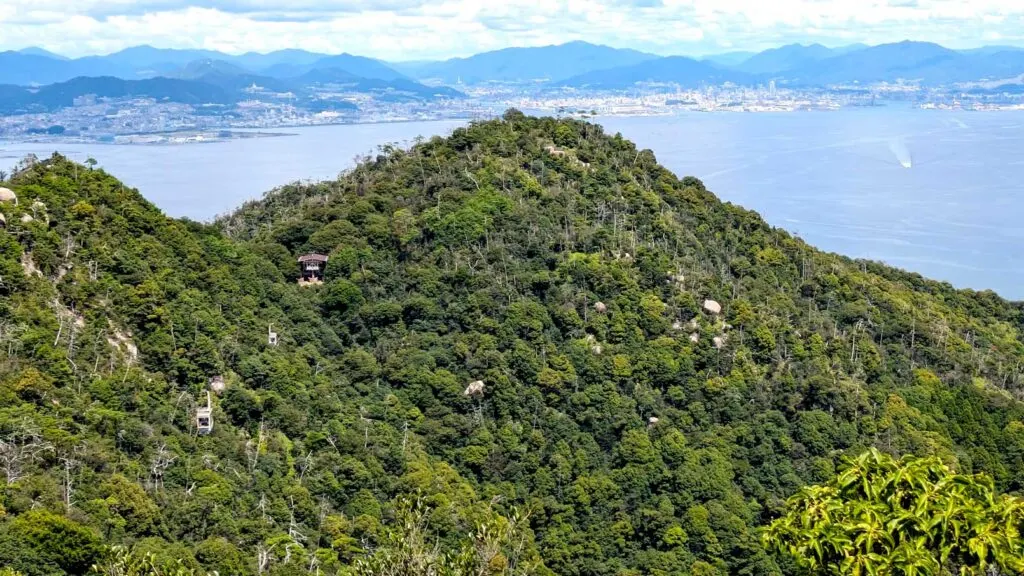
Momijidani Park
Momijidani Park is short walk from the village, and even more beautiful to walk through. It’s mostly in the shade and it’s a very peaceful walk through the forest.
You can stop for photo ops at one of the many picturesque red arched bridges, like Momijidani Bridge.
But you have to stop for food at Momiji-so. I’m not really sure how this place is running, but it’s fun to sit on raised floors in the park and sip on hot ramen on a hot day.
If you are interested in the Miyajima Ropeway, I highly recommend not taking the shuttle on the way down from the last cable car and walking through Momijidani Park instead.
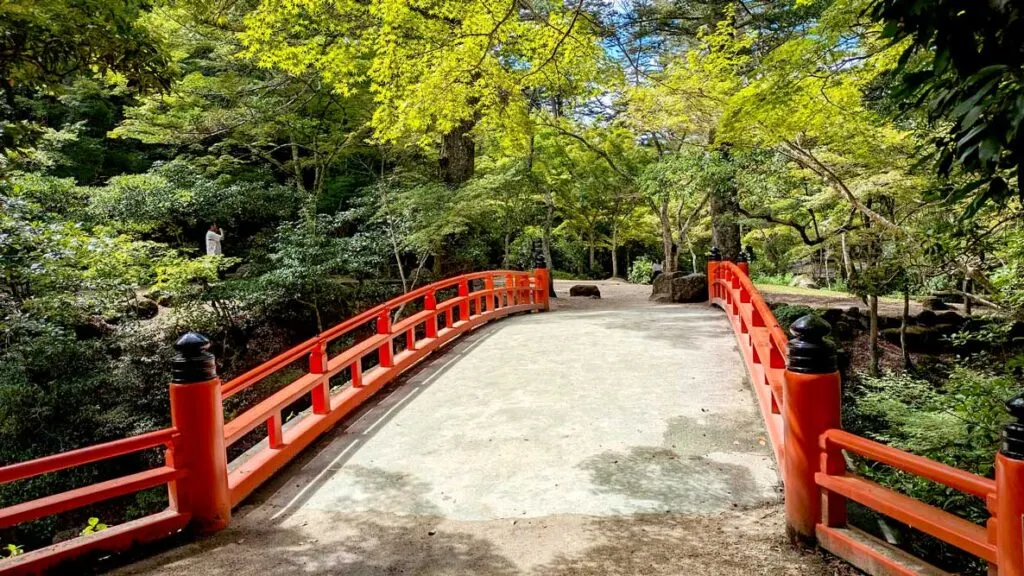
Walk Through Omotesandō Shopping Street (Try Momiji Manjū)
There’s always a market with shops and food stalls to walk through in any proper Japanese city, and Miyajima Island is no exception.
Omotesandō is the ultimate shopping street. It’s outside but completely covered with shades over the top to protect you from the summer sun.
You’ll want to make sure to at least pick up some Momiji manjū, the local wagashi (sweet).
It’s dough that’s usually filled with red bean paste, but today you can find it with many fillings. It is always in the shape of a maple leaf though, to represent the maple trees on the Island.
We picked up ours at Momijido along Omotesandō and they were delicious! This is a fun place to stop at because you can see the whole process of how Momiji manjū are made.
P.S. Omotesandō is also where you can pick up some beer at the Miyajima Brewery, and take out dinner to watch the sunset.
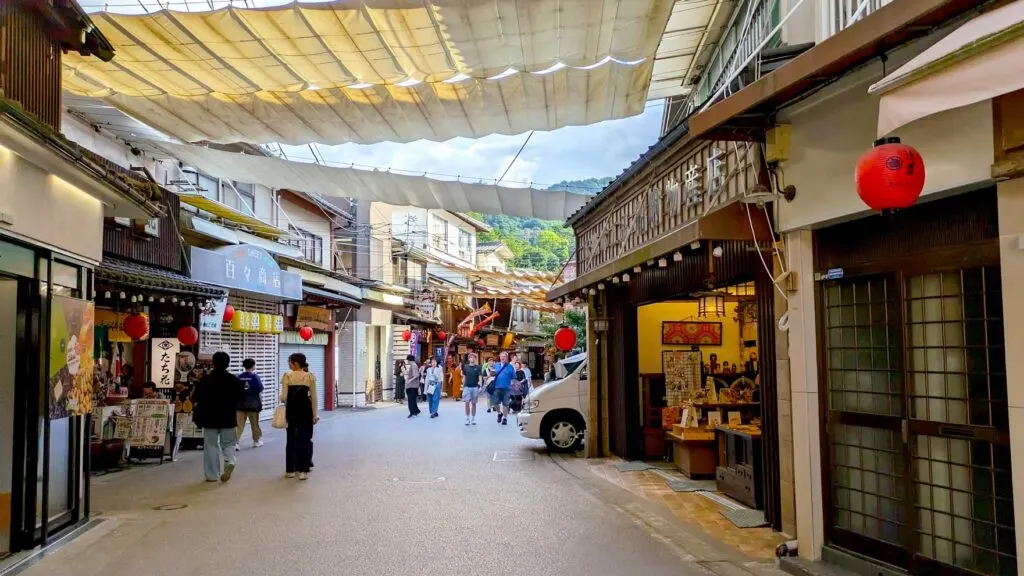
Say Hi To The Local Deer
I was not expecting to be immediately greeted by local deer when arriving on Miyajima Island.
It’s similar to Nara Japan, where deers roam free, and have for centuries.
The deer walk freely through the streets as a pedestrian would, this is their home too after all.
But you do have to watch out, these deer are quite bold and don’t hold back when they see something they want…
We saw deer go up and try to snatch food and paper from people. And then it happened to us, they tried to take our leftover dinner as we were watching the sunset over Ōtorii.
So keep and eye on your belongings for their safety, but also if you don’t want to loose anything!

Miyajima Traditional Crafts Center
The Miyajima Traditional Crafts Centre is the one stop souvenir shop in Miyajima, but also gives you the opportunity to learn a traditional Miyajima skill and bring home a personally made souvenir from Japan.
You can buy a pre-made hand crafted souvenir, but you can also choose to either make your own Momiji Manjū or carve your own traditional Miyajima-Bori. Each activity takes about an hour.
Fun Extras To Do If You Have More Time On Miyajima Island
There are some more things to discover on Miyajima Island if you find yourself with a bit of extra time (waiting for sunset!).
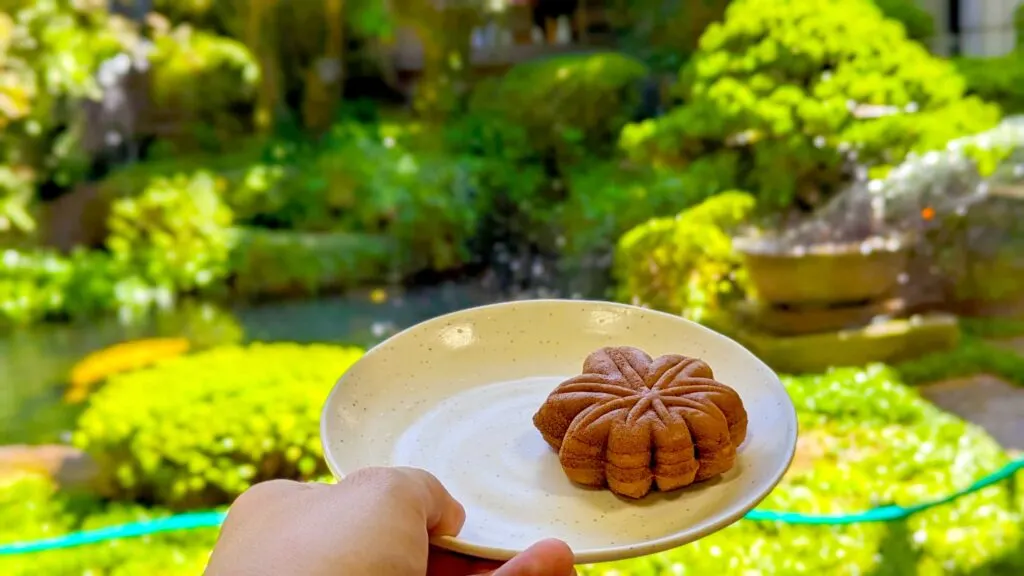
Okeiko Japan: Matcha Ceremony, Kimono, or Calligraphy
We went to Okeiko Japan to learn calligraphy, it was actually a lot of fun, but not the cheapest activity
We were the only ones signed up so had a private course. They teach you techniques for writing with ink, which is a lot easier said than done! It’s really an art that you can see takes years to perfect!
We left with our very own calligraphy rice scoops, which are symbolic on the Island for scooping good fortunes.
They also take photos of you during the lesson and send them to you afterwards which was a nice bonus.
They don’t just offer calligraphy lessons but also a matcha ceremony and wearing a traditional kimono, you can also combine all three experiences.

Diasho-in Temple
The Daisho-in (Daishoin) Temple is a part of the temples on Mount Misen. These are on the base of the mountain, much closer to the town.
It gives you another option if you don’t want to go all the way to the top of Mount Misen.
P.S. you can actually reach the top of Mount Misen from Daisho-in Temple. It would take about an hour and a half to two hours to hike up.
The Miyajima Aquarium
If you’re traveling with your family, or interested in the unique Seto Inland sea life, head to the Miyajima Aquarium.
The aquarium brings the sea life to you from fish to otters, penguins, and whales.
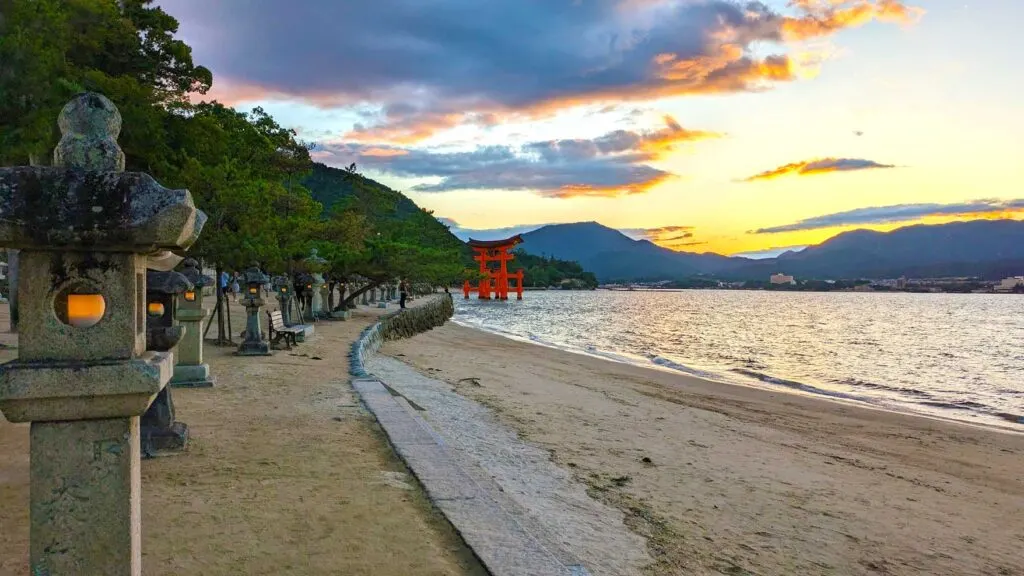

Buy The Travel Bundle & Save
Get everything you need to be a travel pro with my Ultimate Digital Travel Package! It comes with a travel planner, daily travel journal, packing list, and even an Eye Spy game to stay entertained! Everything can be printed, or used digitally on the go!
P.S. As a thank you to my readers, enjoy an extra discount on my Etsy shop with my code ATRLOVE!
My Japan Amazon Essentials
Read More Related Posts
- Honest Review: Ghibli Park Japan Is A Gigantic Waste Of Time
- 10 Yamato Transport Tips For Unbelievably Easy Travel In JapanNot-Your-Typical One Day Osaka Itinerary For The Ultimate Experience
Click Image To Share Or Save This Post
Last update on 2025-05-28 / Affiliate links / Images from Amazon Product Advertising API

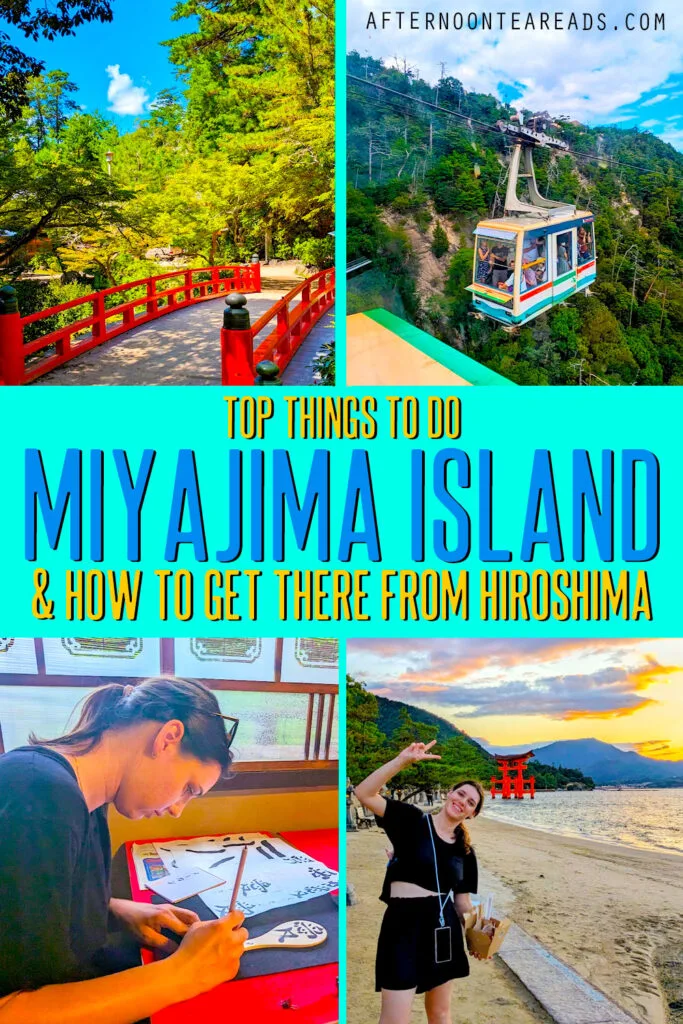




![JISULIFE Handheld Mini Fan, 3 IN 1 USB Rechargeable Portable Fan [12-19 Working Hours] with Power Bank, Flashlight, Pocket Design for Travel/Summer/Concerts/Lash, Gifts for Women (White)](https://m.media-amazon.com/images/I/219a-hROVaL._SL160_.jpg)

